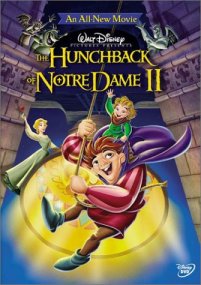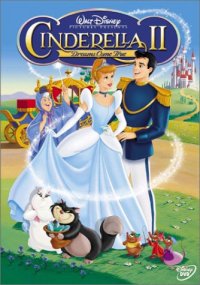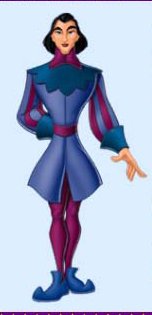|
The Hunchback of Notre Dame II and
Cinderella II: Dreams Come True
Once he gained control of his destiny, Walt Disney refused to do sequels, preferring to always explore new territory in his storytelling. (Before Snow White, he did do a sequel to The Three Little Pigs and hated it. It shows.) Not even the visionary Walt could foresee the empire that bears his name, and the need for product to keep the empire running.
In this age of home video, the real money lies in being able to sell tapes and DVDs; theater tickets not so much. How many times have you noticed a knock-off tape bearing a title suspiciously similar to a Disney film, but not from Disney itself? If someone must profit by ripping off the Disney classics, it had better be Disney. But even a crack theatrical animation studio takes time to produce a film, making it difficult to edge out those rip-off artists.
Luckily for the Disney company, they have a television animation arm, capable of churning out "movies" at a much faster rate. The results may not be as smooth and lush as the originals, but at least they keep beloved public domain characters in the hands of the mouse. And whatever you may feel about the very idea of doing sequels to movies that were not intended to have them, the kids really, really love them. (In my house, Scamp's Adventure, bought on tape, is almost worn through.)
Sometimes the results are better than necessary; just last month Disney deemed Return To Neverland worth a theatrical run before going to video, and surprisingly, they were right. The team working on that project clearly cared, and obviously had affection for the original Peter Pan.
On the heels of that, Disney delivered another two sequels, this time direct to video. The two DVDs demonstrate both the strengths and the weaknesses of their current determination to keep all their versions of their characters in the public eye.
Cinderella II: Dreams Come True feels like a product rushed through. To be fair, it's kind of hard to come up with a sequel when the first story clearly says, "they lived happily ever after." So instead the Disney Studios come up with three and a half stories; the mice want to write a book of memories for Cinderella, and the Fairy Godmother helps.
It heavily borrows themes from Ever After. In the first story, Cinderella tries to be a perfect princess, but realizes that she must be true to herself. Later, she helps her stepsister Anastasia (not quite so wicked, just whiny) find true love with the town baker. The only sequence that takes off is one in which lead mouse Jaq wishes to be a human. But because all of this video is aimed for the very young, the sequence quickly runs out of steam.
From its episodic nature, it seems likely that at one time Disney considered doing a series with adventures in Cinderella's castle, changed their minds, and slapped this together. It has the look of their daily shows, the weaknesses of which DVD tends to accentuate. In some places it could be confused for (gasp) Hanna-Barbera circa 1972.
Little girls may be fascinated by it (over and over and over again), and like most of the Disney DVDs, it includes a storybook which will also keep their attention. And finally Disney has put out DVD-ROM features that work on a Mac; they've included a preview version of a Cinderella dress-up game forthcoming from their software arm. Like I said, this is a disc for little girls; anyone else need not pay attention.
However, The Hunchback of Notre Dame II aims higher and for the most part succeeds. It doesn't have the same depth as its predecessor, either artistically or story-wise, but at least the studio made an effort to fall somewhere between feature quality and daily television.
Where the first one had a dark menace to it, everything here has been lightened. Instead of the mocking Festival of Fools, all of Paris now prepares for the Festival of Love, in which couples declare their undying devotion to each other while Quasimodo, now perfectly accepted in society, rings La Fidel, a great bejeweled bell. Phoebus and Esmerelda now have a son, Zephyr, to whom Quasi acts as godfather.
Yes, things have certainly turned around for the hunchback, but he still has not found love. Esmerelda advises him to have patience, while the gargoyles continue coaching him on how to be his best.
Coincidentally, an evil circus pulls into Paris, Le Cirque Du Sarouche. They travel from town to town, fleecing its citizens, often using the fair Madeleine as a distraction. And today their target is La Fidel.
Yes, it's a far cry from the threats of genocide and religious persecution that ran through the original. In fact, there's barely acknowledgment that Notre Dame is a church at all. But this makes it somewhat safer as a family film. (You may have noticed that the first one was not as marketable as Disney would have liked. Not that they didn't try.)
By reassembling the original cast, Disney has kept this from being generic. Kevin Kline could not give a boring line reading if his life depended on it. They've added to the cast with Haley Joel Osment as Zephyr, Jennifer Love Hewitt as Madeleine, and the always dependable Michael McKean as the villainous Sarouche.
The animators have risen to the challenge of this voice work, in particular with Sarouche. He rises above stock villainy; though he's no Judge Frollo, he'll do. Also lurking around is a mute grotesque dwarf that has been given a sly commentary role. With the main characters, they made the effort to use the original's design; only Madeleine looks like she came from stock animation casting.
In both movies there's an element of inconsistency, though in Hunchback II it's kept fairly minimal. Each story in Cinderella II has slightly differing character design, and no one pronounces Jaq the same way twice. With the Parisian adventure, the worst sin lies in color correction - the dusky gypsy Esmerelda varies wildly in hue, and it seems they couldn't decide if Quasimodo and Madeleine dress in new or old clothes.
Both discs also include musical extras, with Hewitt's song contribution actually being listenable. The Hunchback disc also forgoes the usual Disney trivia game, instead offering some interactive games teaching children music and dance. Returning gargoyle Jason Alexander is even given a poem to recite, "It's Not Easy Being A Gargoyle." There's a bit of a dark streak to it, and despite its reliance on computer animation, it just might get kids interested in researching actual gargoyles.
These are far from the last sequels we'll see this year, and if those to follow will be on the level of The Hunchback of Notre Dame II, this might be okay. Purists will still be upset, but in the face of the inevitable, they should at least be not nearly annoyed as they could be. And Fanboy Planet will serve as their guide.
Cinderella II - Dreams Come True
The Hunchback of Notre Dame II















